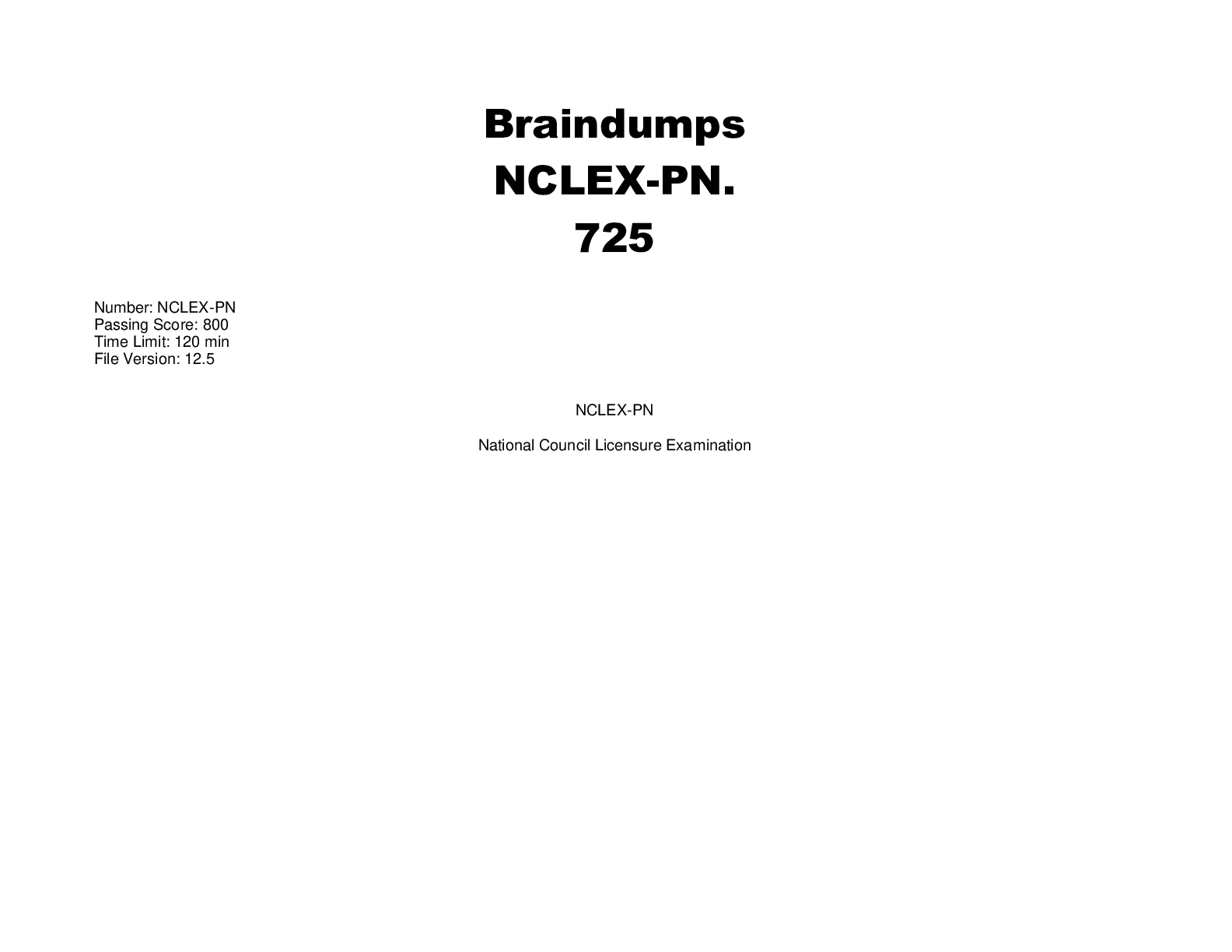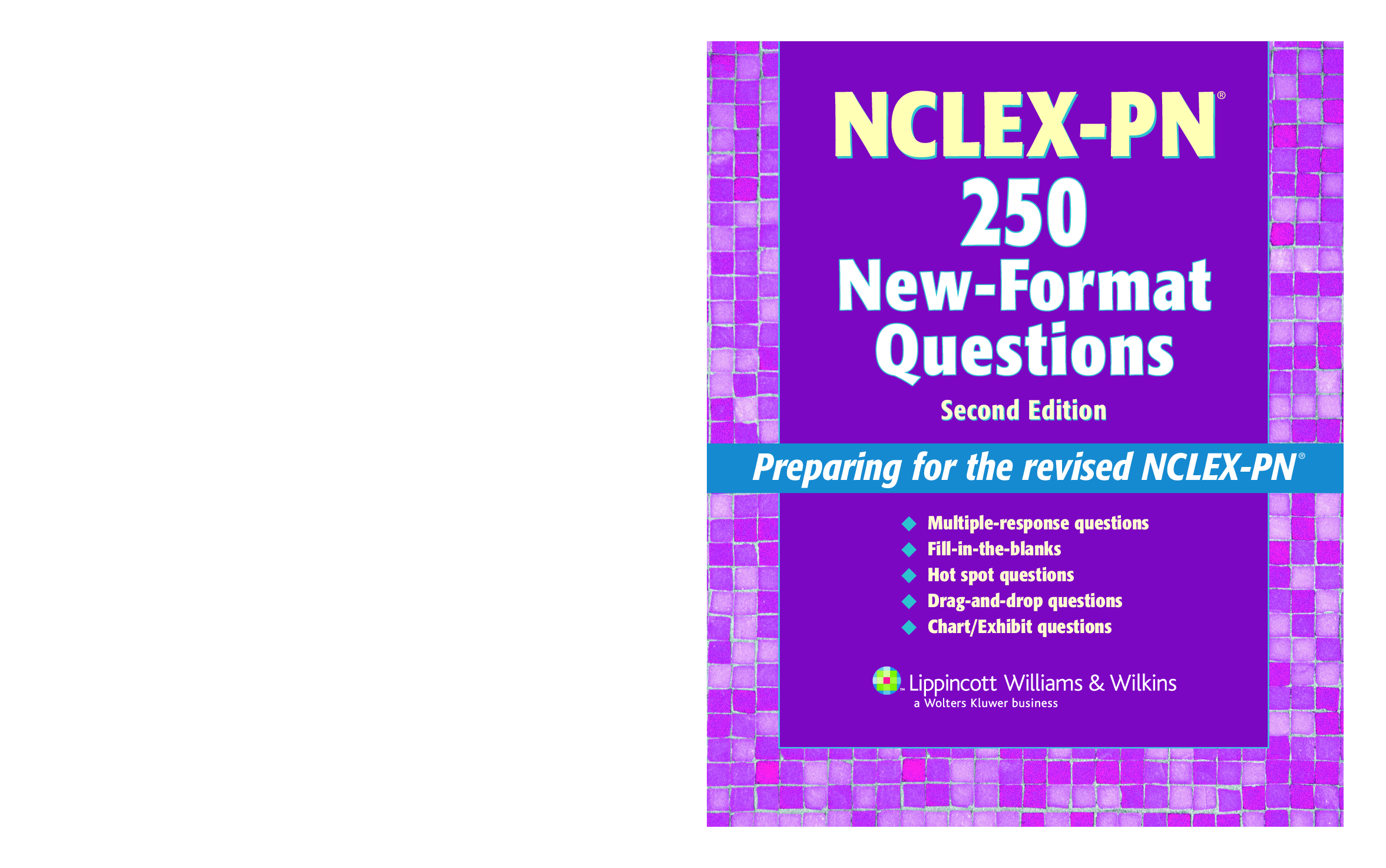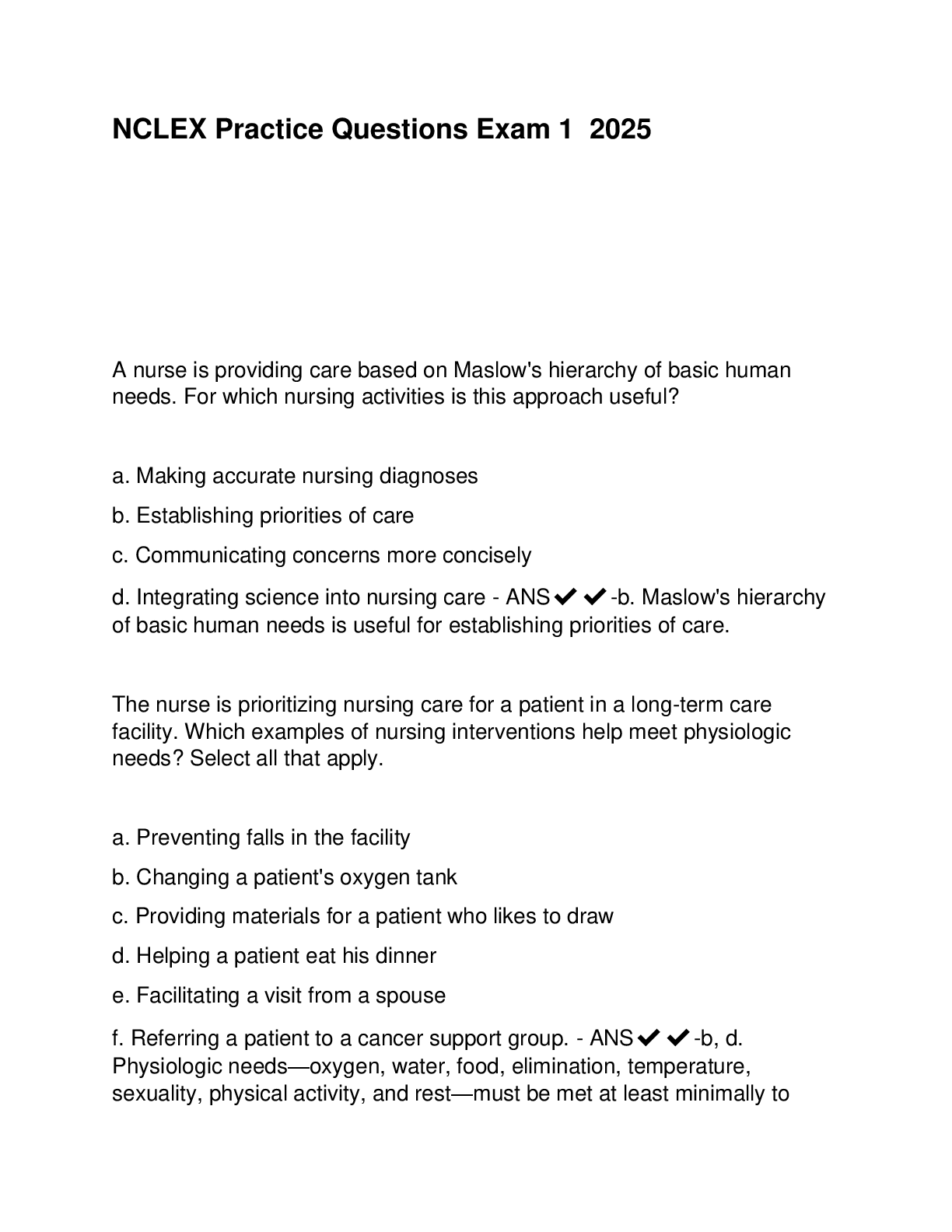Strategy - Maslow's Hierarchy of Needs Theory
Document Content and Description Below
Strategy - Maslow's Hierarchy of Needs Theory 1) A preoperative client is scheduled for adrenalectomy to remove a pheochromocytoma. The nursewould most closely monitor which item in the preoperative... period? Vitalsigns Hypertension is the hallmark symptom of pheochromocytoma. Severe hypertension can precipitate a stroke (brain attack) or sudden blindness. Although all of the items are appropriate nursing assessmentsfor the client with pheochromocytoma, the priority is to monitor the vital signs, especially the blood pressure. 2) A mother brings her child to the emergency department. Based on the child's sitting position, drooling, and apparent respiratory distress, a diagnosis of epiglottitis is suspected. The nurse shouldplan for which priority intervention? Providing assisted ventilation and obtaining the necessary equipment The highest priority with epiglottitis is to have assisted ventilation available because the highest risk withthis child is complete airway obstruction. Therefore, interventions related to airway are the priority. Physiological interventions continue to have the highest priority, with assessment of breath and heartsounds and then obtaining pulse oximetry being priorities. Once the airway is stabilized, the temperature, weight, and a chest x-ray can be obtained. The last priority is asking about precipitating events, which is done once physiological needs are met. 3) The nurse gives a dose of diazepam to an assigned client. What is the most important action to betaken by the nurse before leaving the room? Instituting safety measures Diazepam is a sedative hypnotic that also has anticonvulsant and skeletal muscle relaxant properties. Thenurse should institute safety measures before leaving the client's room to prevent injury as a result of medication side effects, which include dizziness, drowsiness, and lethargy. The other options listed are useful but not essential to the client's safety in this situation. 4) An understanding of borderline personality disordershould help the nurse determine that whichproblem is the priority for the client? Risk forself-harm Clients with borderline personality disorder are most often hospitalized because of impulsive attempts atself-mutilation or suicide. The nursing intervention of constant close observation is usually initiated to protect the client from impulsive behavior. If any of the other options exist, they are of lesser priority. 5) The nurse is planning care for a postpartum client who had a vaginal delivery 2 hours ago. The clientrequired an episiotomy and has several hemorrhoids. What is the priority nursing consideration for this client? Client pain level The priority nursing consideration for a client who delivered 2 hours ago and who has an episiotomy andhemorrhoids is client pain level. Most clients have some degree of discomfort during the immediate postpartum period. There are no data in the question that indicate inadequate urinary output, the presence of client perception of body changes, and potential for imbalanced body fluid volume. 6) A clinic nurse is performing an admission assessment on an African American client scheduled for cataractremoval with intraocular lensimplantation. Which question should the nurse avoid asking onthe initial assessment? "Do you have any family problems?" In the African American culture, it is considered to be intrusive to ask personal questions on the initial contact or meeting. African Americans are highly verbal and express feelings openly to family or friends,but what transpires within the family is viewed as private. The psychosocial assessment would be of lowest priority during the initial admission assessment. Additionally, because cardiovascular, renal, andgastrointestinal assessments are physiological, they are the priority assessments. 7) The nurse is preparing to care for a client with immunodeficiency. The nurse should plan to addresswhich problem as the priority? Risk for infection The client with immunodeficiency hasinadequate or no immune bodies and is atrisk forinfection. Thepriority concern would be risk for infection. The question presents no data indicating that the client is experiencing anxiety. Fatigue may be a problem and the client may need to be placed on protective isolation, but these are not the priority problems for this client. Infection can be life-threatening and is the priority. 8) A client recently admitted to the hospital in the manic phase of bipolar disorder is unkempt, taking antipsychotic medications, and complaining of abdominal fullness and discomfort. Which interventionaddresses the priority sign/symptom? Encourage frequent fluid intake and a high-fiber diet. Constipation is a common elimination problem with clients in a manic phase of bipolar disorder. Constipation may occur as the result of a combination of factors, including taking antipsychotic medications, suppressing the urge to defecate, and a decreased fluid intake as a result of the manic activity level. The symptoms listed in the question in combination with antipsychotic medications are indicators of constipation. A high-fiber diet and increased fluids can reduce constipation. 9) A client arrives in the emergency department in a crisis state demonstrating signs of profoundanxiety. What should the initial nursing assessment focus on? The client's physical condition The initial nursing assessment of a client in a crisis state isto evaluate the physical condition of the client,the potential for self-harm, and the potential for harm to others. Once this has been determined and appropriate interventions have been initiated, the nurse would then proceed with the mental health interview that involves the remaining options. 10) The nurse is collecting data from an African American client scheduled for surgery. Which questions would be most appropriate forthe nurse to ask on initial assessment? Select all that apply. "Do you ever experience chest pain?" "Do you have any difficulty breathing?" "Do you frequently have episodes of headache?" In the African American culture, it is considered to be intrusive to ask personal questions on the initial contact ormeeting. African Americans are highly verbal and expressfeelings openly to family orfriends,but what transpires within the family is viewed as private. Psychosocial data are the least priority duringthe initial data collection. Additionally, cardiovascular, neurological, and respiratory data include physiological assessments that would be the priority. 11) The nurse has created a plan of care for a client experiencing dystocia and includes several nursingactions in the plan of care. What is the priority nursing action? Monitoring the fetal heart rate Dystocia is difficult labor that is prolonged or more painful than expected. The priority is to monitor the fetal heart rate. Although providing comfort measures, changing the client's position frequently, and keeping the significant other informed of the progress of the labor are components of the plan of care,the fetal status would be the priority. 12) During the assessment, whatisthe nurse's primary goalfor a confused and disoriented clientdiagnosed with posttraumatic stress disorder? Making the client feel safe It is important to make a confused client feel safe. Explaining the unit rules and orienting the client tothe unit are part of any admission process. Stabilizing psychiatric needs is a long-term goal. 13) The nurse caring for a client with a diagnosis of acute schizophrenia should use which approachwhen planning care? Provide assistance with grooming and nutrition until the client's thinking has cleared. In the acute phase, the nurse must assume responsibility for planning for the client's basic human needs,such as nutrition, hygiene, sleep, and activities of daily living. As the nurse plans care for the schizophrenic client, it is important to understand the client's developmental stage and ability to accept the disease. The client lacks insight and may not be aware of the illness because of the severe decompensation in thinking. Including the client in decision making at this point is incorrect because these actions do not provide a structured routine. Repeatedly pointing out inconsistencies is a nontherapeutic communication technique. 14) The nurse is preparing a plan of care for a client with diabetes mellitus who has hyperglycemia.The nurse places priority on which client problem? Inadequate fluid volume An increased blood glucose level will cause the kidneys to excrete the glucose in the urine. This glucose is accompanied by fluids and electrolytes, causing an osmotic diuresis leading to dehydration. This fluid loss must be replaced when it becomes severe. Options 1, 3, and 4 are not related specifically to the information in the question. 15) The nurse is conducting an admission assessment on an African American client scheduled for ahernia repair. Which assessment data are of least importance during the initial assessment? Psychosocial assessment data The psychosocial assessment is the least priority during the initial admission assessment. In the AfricanAmerican culture, it is considered intrusive to ask personal questions on the initial contact or meeting. Additionally, cardiovascular, neurological, and respiratory assessments include physiological assessments, which would be the priority assessments. 16) A client with a history of panic disorder comesto the emergency department and states to thenurse, "Please help me. Ithink I'm having a heart attack." What isthe priority nursing action? Assess the client's vitalsigns. Clients with panic disorders experience acute physical symptoms, such as chest pain and palpitations.The priority is to assess the client's physical condition to rule out a physiological disorder. Therefore,options 2, 3, and 4 are not the priority. 17) The charge nurse is planning the assignment for the day. Which factors should the nurse remainmindful of when planning the assignment? Select all that apply. The acuity level of the clients Client needs and workers' needs and abilities There are guidelinesthat the nurse should use when delegating and planning assignments. These includethe following: ensure client safety; be aware of individual variations in work abilities; determine which tasks can be delegated and to whom; match the task to the delegatee on the basis of the nurse practice act and appropriate position descriptions; provide directions that are clear, concise, accurate, and complete; validate the delegatee's understanding of the directions; communicate a feeling of confidence to the delegatee and provide feedback promptly after the task is performed; and maintain continuity of care as much as possible when assigning client care. Staff requests, convenience as in clustering client rooms, and anticipated changes in unit census are not specific guidelines to use when delegating and planning assignments. [Show More]
Last updated: 2 years ago
Preview 1 out of 24 pages

Buy this document to get the full access instantly
Instant Download Access after purchase
Buy NowInstant download
We Accept:

Reviews( 0 )
$10.00
Can't find what you want? Try our AI powered Search
Document information
Connected school, study & course
About the document
Uploaded On
Aug 20, 2021
Number of pages
24
Written in
Additional information
This document has been written for:
Uploaded
Aug 20, 2021
Downloads
0
Views
217









